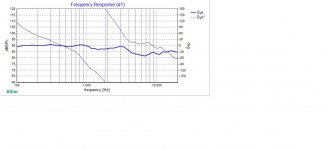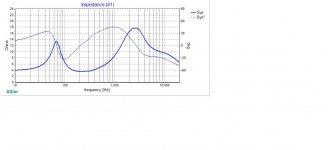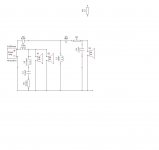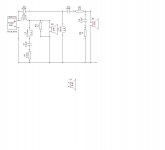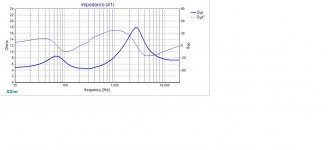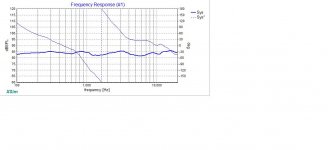I was about to say very similar things, but Dave, you beat me to them.
There is very rarely any good reason to use more than one tweeter. And your crossover points seem to be too high. Do you have any reason to choose them? Which drivers are you using? I'm very curious to see specifically which mids you wish to use, considering that you are thinking of letting them play till 5K or 6K.
There is very rarely any good reason to use more than one tweeter. And your crossover points seem to be too high. Do you have any reason to choose them? Which drivers are you using? I'm very curious to see specifically which mids you wish to use, considering that you are thinking of letting them play till 5K or 6K.
I think a configuration like that is going to be extremely challenging. I've seen some discussion in the past about using two tweeters, but I've never really understood why, as Dave and tcpip mention, it is likely to cause grief. As far as understanding the lobing, your best way is to actually make a baffle and mount at least the tweeters and M's and do vertical off axis measurements. (This is something I'm yet to tackle doing myself, as they are more challenging than horizontal off access).
The other option would be to use abec R&D-Team - Products I've not yet tried to learn this, the learning curve seems brutal, DonVK has done some impressive modeling with it.
If you don't care so much about the vertical off axis then you can design for listening height and just accept that if you stand up it is likely going to sound off. But even that I'm unsure of with that configuration.
Tony.
The other option would be to use abec R&D-Team - Products I've not yet tried to learn this, the learning curve seems brutal, DonVK has done some impressive modeling with it.
If you don't care so much about the vertical off axis then you can design for listening height and just accept that if you stand up it is likely going to sound off. But even that I'm unsure of with that configuration.
Tony.
I think the basic problem is that multiple tweeters are going to reduce the sharpness of the soundstage and ability to localize the sound sources. Localisation is done more with the help of the high frequencies. If we have one tweeter, then at least we can pretend we have an overall point source for the speaker. If we have more than one, they start interfering in the high frequencies and mess up the soundstage.
Multiple point sources have this impact even at lower frequencies, but the impact is not as acute as in the highs.
Linkwitz refused to have multiple drivers working in parallel primarily for this reason, AFAIK. He did an MTM with his first design (Phoenix) and then completely refused to do it for his other designs.
And the associated thought we all get is: why?? Why do you want to do multiple tweeters? We do multi-driver because we can't get the bass impact or high SPL at low excursion with one driver. For instance a multi-midbass design for MTM is a compromise: we don't want to do a proper 3-way for space or cost reasons. A multi-woofer design is done, usually at high cost, to let the woofer drivers operate with less excursion. The tweeter is the only place where we are never at a loss for SPL or excursion, at least for home audio. Why would you add a second driver there?
Multiple point sources have this impact even at lower frequencies, but the impact is not as acute as in the highs.
Linkwitz refused to have multiple drivers working in parallel primarily for this reason, AFAIK. He did an MTM with his first design (Phoenix) and then completely refused to do it for his other designs.
And the associated thought we all get is: why?? Why do you want to do multiple tweeters? We do multi-driver because we can't get the bass impact or high SPL at low excursion with one driver. For instance a multi-midbass design for MTM is a compromise: we don't want to do a proper 3-way for space or cost reasons. A multi-woofer design is done, usually at high cost, to let the woofer drivers operate with less excursion. The tweeter is the only place where we are never at a loss for SPL or excursion, at least for home audio. Why would you add a second driver there?
Linkwitz refused to have multiple drivers working in parallel primarily for this reason, AFAIK. He did an MTM with his first design (Phoenix) and then completely refused to do it for his other designs.
With an MTM if you get the Ms within g a quarter wavelength at the XO then the problems disappear.
dave
Yes, all of us MTM designers try pushing down the crossover frequency. I guess in general, lower crossover frequencies are a good idea wherever possible to reduce lobing? Of course there are counter-factors which make us push the Fc up too...
I just did some arithmetic and wasn't too happy with the result. A typical 6.5" midbass and 1" dome tweeter midbass, with a (typical) 4" front plate for the tweeter, will not be able to do a C-to-C distance less than about 12" if placing the three drivers in one column. The wavelength of sound at 1500Hz, which is about as low as one can hope to go with a good tweeter, is about 23cm. A quarter of 23cm as upper limit of C-to-C distance? I'll never come even close.
The one place where I am unable to find any upside is adding a second tweeter.
I just did some arithmetic and wasn't too happy with the result. A typical 6.5" midbass and 1" dome tweeter midbass, with a (typical) 4" front plate for the tweeter, will not be able to do a C-to-C distance less than about 12" if placing the three drivers in one column. The wavelength of sound at 1500Hz, which is about as low as one can hope to go with a good tweeter, is about 23cm. A quarter of 23cm as upper limit of C-to-C distance? I'll never come even close.
The one place where I am unable to find any upside is adding a second tweeter.
Last edited:
Thanks everyone for your replies and wisdom. I really appreciate it.
The crossover points are based on maximizing the positives of the drivers. They're based on dispersion, distortion and energy storage behaviors.
The drivers are Yamaha beryllium tweeters and midranges. The midrange dispersion is best under 7kHz. The tweeters performance was best above 4kHz. It worked out complimentary for the pairing.
Yeah, what I was thinking was destructive interference could occur between the two tweeters as the listener height is changed, especially at the distances of these tweeter's magnets/frames.There is very rarely any good reason to use more than one tweeter. And your crossover points seem to be too high. Do you have any reason to choose them? Which drivers are you using? I'm very curious to see specifically which mids you wish to use, considering that you are thinking of letting them play till 5K or 6K.
The crossover points are based on maximizing the positives of the drivers. They're based on dispersion, distortion and energy storage behaviors.
The drivers are Yamaha beryllium tweeters and midranges. The midrange dispersion is best under 7kHz. The tweeters performance was best above 4kHz. It worked out complimentary for the pairing.
Yeah, I've always been set against using more than 1 tweeter per channel. My change of heart is cosmetic and based on other's (audiophiles) opinions. It seemed some o the very expensive high end speakers had more than one tweeter per channel in a MTTM format, so I thought it might be worth checking if it's doable. It defied my previous understanding of the mathematics (and should introduce cancellations at intervals), but I thought there might be some other science to it. If not, I'll do a conventional build.I've seen some discussion in the past about using two tweeters, but I've never really understood why, as Dave and tcpip mention, it is likely to cause grief...
Hello everyone
I am not sure if this is the best place or not, so please guide me if not. Has anyone here spent a lot of time in magnet motor design?
I ask as I find that in my 2 years of developing my own driver that the results I get from FEMM do not reflect the real world results I am getting. Example would be recently expecting a value of 1.000T within a magnetic gap but getting 0.733T. Have tried multiple magnets from multiple manufacturers and also different variants of steel.
Also, is there any thread more suitable to discuss cone profiles, material choices for cone / surrounds etc?
Thanks for reading
Paul
I am not sure if this is the best place or not, so please guide me if not. Has anyone here spent a lot of time in magnet motor design?
I ask as I find that in my 2 years of developing my own driver that the results I get from FEMM do not reflect the real world results I am getting. Example would be recently expecting a value of 1.000T within a magnetic gap but getting 0.733T. Have tried multiple magnets from multiple manufacturers and also different variants of steel.
Also, is there any thread more suitable to discuss cone profiles, material choices for cone / surrounds etc?
Thanks for reading
Paul
You can start your own thread, title it "DIY Driver Design." Presuming you want to make limited-range drivers (woofer, midrage and/or tweeter), it probably belongs here in Multi-Way, else put it in the Fullrange subforum like the thread I link to below.Hello everyone
I am not sure if this is the best place or not, so please guide me if not. Has anyone here spent a lot of time in magnet motor design?
This sort of thing is definitely on my diy audio bucket list, but I don't suppose there's enough interest to make a separate Driver Design and Building subforum. For non-standard reproducers (electrostatic, ribbon and such) there's the Planars & Exotics, but I don't think "standard" drivers would fit in there.
Here's the thread on making a full range driver, it's more pics than solid tech info:
Custom DIY 8" Fullrange Driver
Edited to add:
I remember seeing that one back when, but I forgot about it, good one...Spike, try this thread.
Last edited:
Loudspeaker design considerations
Hi, I have a homepage dealing with DiY speaker design, and I thought I'd share the link to this page: A few basic considerations about loudspeaker design.
If you're interested and would read through it, please tell me, if you find some error or some serious deficiency. I think private message is better.
Istvan
Hi, I have a homepage dealing with DiY speaker design, and I thought I'd share the link to this page: A few basic considerations about loudspeaker design.
If you're interested and would read through it, please tell me, if you find some error or some serious deficiency. I think private message is better.
Istvan
I had a quick look at your page. Some early comments.
First, powr handling in a domestic loudspeaker is almost meaningless, with no way to compare brands as there is no standard for specifiying it.
Two, no mention of solving the XO issue by just not using one.
The Baffle Step section could be expanded. Ways to compensate for BS, more information on the bipole dip (which gets smaller with a box that has a higher width to depth ratio or the addition of a high pass (electrical or acoustic) to the “rear” driver.
It does seem to come from an orthodox POV, and misses some really good stuff.
dave
First, powr handling in a domestic loudspeaker is almost meaningless, with no way to compare brands as there is no standard for specifiying it.
Two, no mention of solving the XO issue by just not using one.
The Baffle Step section could be expanded. Ways to compensate for BS, more information on the bipole dip (which gets smaller with a box that has a higher width to depth ratio or the addition of a high pass (electrical or acoustic) to the “rear” driver.
It does seem to come from an orthodox POV, and misses some really good stuff.
dave
Hi, I have a homepage dealing with DiY speaker design, and I thought I'd share the link to this page: A few basic considerations about loudspeaker design.
If you're interested and would read through it, please tell me, if you find some error or some serious deficiency. I think private message is better.
Istvan
Thanks you
A nice read
I had a quick look at your page. Some early comments.
First, powr handling in a domestic loudspeaker is almost meaningless, with no way to compare brands as there is no standard for specifiying it.
Two, no mention of solving the XO issue by just not using one.
The Baffle Step section could be expanded. Ways to compensate for BS, more information on the bipole dip (which gets smaller with a box that has a higher width to depth ratio or the addition of a high pass (electrical or acoustic) to the “rear” driver.
It does seem to come from an orthodox POV, and misses some really good stuff.
dave
May I ask that it means to be non orthodox for example?
Some examples for me to read/google?
Thanks
May I ask that it means to be non orthodox for example?
FR speakers, horns, speakers designed with current amps or near current amp status. I’d have to read read the whole article to expand on that.
dave
FR speakers, horns, speakers designed with current amps or near current amp status. I’d have to read read the whole article to expand on that.
dave
Ok I get what you mean!
Thanks
Thanks all!
Perhaps I should have first mentioned that in this page I was going to deal with the most orthodox closed box and vented designs with passive crossover, not with full-range, dipole, horn, TL etc, not with active crossovers. This page is meant for beginners, and contains many oversimplifications. It's not so in-depth and not for people who are already experienced in DiY speaker design. Nor does it contain information about the specifics, for example on how to use some preferred free design or measurement software or how to solve some problems like the baffle step in practice. It was only meant to provide basic theory and guidelines, and call people's attention to the basic priciples that should be taken into account for the most often used and simplest loudspeaker designs. People who want to design audiophile or high-end speakers should consult more sophisticated theoretical articles and more in-depth discussions.
Istvan
Perhaps I should have first mentioned that in this page I was going to deal with the most orthodox closed box and vented designs with passive crossover, not with full-range, dipole, horn, TL etc, not with active crossovers. This page is meant for beginners, and contains many oversimplifications. It's not so in-depth and not for people who are already experienced in DiY speaker design. Nor does it contain information about the specifics, for example on how to use some preferred free design or measurement software or how to solve some problems like the baffle step in practice. It was only meant to provide basic theory and guidelines, and call people's attention to the basic priciples that should be taken into account for the most often used and simplest loudspeaker designs. People who want to design audiophile or high-end speakers should consult more sophisticated theoretical articles and more in-depth discussions.
Istvan
first crossover design help
Hi I have some components on hand from a set of thor speakers the mag drivers are corroded so I am replacing with seas Nextel speakers. After reading the design your own speaker from scratch I have been working on using the existing cross over with modification. Attached are two options one is to use the small thor cabinets the other is to build a smaller TM cabinet the two crossovers and graphs are attached. I read about the impedance area and have reduced it but I do not know what the max impedance should be or what the impact is of having high inconsistent impedance is I understand low impedance stresses the amp. I would also feel better if I knew that neither crossover will destroy the tweeter. I would like to reuse as much as possible and buy as little as possible. Any help would be appreciated. Cabinet suggestions would also be appreciated. All of my rooms are relatively small and we listen at low to mid volume. I would like to line up the drivers by moving the mid or mids out if that would not hurt anything
thank you
Hi I have some components on hand from a set of thor speakers the mag drivers are corroded so I am replacing with seas Nextel speakers. After reading the design your own speaker from scratch I have been working on using the existing cross over with modification. Attached are two options one is to use the small thor cabinets the other is to build a smaller TM cabinet the two crossovers and graphs are attached. I read about the impedance area and have reduced it but I do not know what the max impedance should be or what the impact is of having high inconsistent impedance is I understand low impedance stresses the amp. I would also feel better if I knew that neither crossover will destroy the tweeter. I would like to reuse as much as possible and buy as little as possible. Any help would be appreciated. Cabinet suggestions would also be appreciated. All of my rooms are relatively small and we listen at low to mid volume. I would like to line up the drivers by moving the mid or mids out if that would not hurt anything
thank you
Attachments
Semisphere glass subwoofer with dual Vifa PJ-W17-00-08
Hi All
Thought i'd post this idea that is running around my head for an unconventional speaker design.
I went shopping at the local recycling centre a few weeks ago, intent on finding something that I could modify into an oddly designed speaker box.
I had no size in mind, but do have 4 x 6.5" Vifas and 4 x D25 Vifa Tweeters that are not being used, so kept those in consideration.
Other options were to retro fit an old boombox into some other enclosure or design some kind of Bluetooth speaker box. (I have an old Panasonic solid state boombox and a vintage suitcase for that project)
I came home with several items, but the one I was most excited about, was this mid century 20" diameter Holophane Industrial Warehouse light.
I paid AUD$10 for it. The conundrum is, as pictured, it's worth 50 times the cost price as an old school modern industrial light fixture. Powercoated and wired for LED, it could sel for AUD $2500, to the right person.
But sound waves are more interesting.
This Holophane light shade (thick borosilicate glass), is 20" wide and has a volume of approx. 35-36 litres, including the ballast mount (semisphere glass only is 33.1L or 1.168 ft3)
Using the Vifa drivers, I was thinking of either a push pull config, which the volume would be suited to, or a dual firing set.
Is this a vaild design process to be thinking about?
I have done some research on breaking borosilicate glass with low frequency sound waves and have come up empty, so, my best guess, is, this could work?
What do the masses think?
Hi All
Thought i'd post this idea that is running around my head for an unconventional speaker design.
I went shopping at the local recycling centre a few weeks ago, intent on finding something that I could modify into an oddly designed speaker box.
I had no size in mind, but do have 4 x 6.5" Vifas and 4 x D25 Vifa Tweeters that are not being used, so kept those in consideration.
Other options were to retro fit an old boombox into some other enclosure or design some kind of Bluetooth speaker box. (I have an old Panasonic solid state boombox and a vintage suitcase for that project)
I came home with several items, but the one I was most excited about, was this mid century 20" diameter Holophane Industrial Warehouse light.
An externally hosted image should be here but it was not working when we last tested it.
I paid AUD$10 for it. The conundrum is, as pictured, it's worth 50 times the cost price as an old school modern industrial light fixture. Powercoated and wired for LED, it could sel for AUD $2500, to the right person.
But sound waves are more interesting.
This Holophane light shade (thick borosilicate glass), is 20" wide and has a volume of approx. 35-36 litres, including the ballast mount (semisphere glass only is 33.1L or 1.168 ft3)
Using the Vifa drivers, I was thinking of either a push pull config, which the volume would be suited to, or a dual firing set.
Is this a vaild design process to be thinking about?
I have done some research on breaking borosilicate glass with low frequency sound waves and have come up empty, so, my best guess, is, this could work?
What do the masses think?
- Home
- Loudspeakers
- Multi-Way
- Design your own speaker from scratch discussion thread
